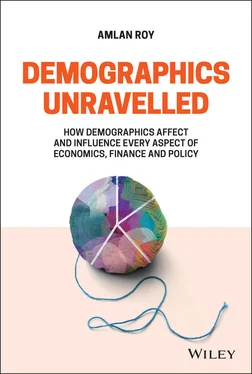Both the consumer opportunity set and the preferences of consumers have changed as the world has globalised, information and education have increased awareness, and companies have innovated over time. The affordability of technological and consumer products has undergone radical changes on many fronts, which would have been hard to forecast 10 or 20 years ago even by visionaries, futurists, or pioneering innovators.
People (consumers and workers) were at the core of modern economics, as elaborated by Adam Smith's The Wealth of Nations (1776) and The Theory of Moral Sentiments . People's behaviour was also central in John Maynard Keynes' The General Theory of Employment, Interest and Money (1936). Keynes coined the term animal spirits to capture the emotions, impulses, and tendencies that influence human behaviour and used it to explain investor decisions of buying and selling assets during times of uncertainty and stress. Psychology and deviations from perfect rationality have also been highlighted by Daniel Kahnemann and Amos Tversky 5 , who highlighted cognitive biases in decision-making, and Richard Thaler 6 , 7 , who highlighted deviations from rationality in economics and the importance of behavioural economics. One of the pioneers of decision-making in organisations as well as artificial intelligence was Herbert Simon, who took an interdisciplinary approach to organisational decision-making and developed the concepts of bounded rationality and satisficing . My perspective fundamentally includes the behaviour of consumers and workers as a reflection of their characteristics.
I have another criticism of the conventional popular perception of demographics being long-term in its effects. Consumers and workers make direct contributions to the economic output of a country, a region, or the world, as mentioned earlier. Additionally, they influence inflation through effects on both the demand and supply sides. The wages consumer demands and labour costs of workers have short-term as well as medium-term and long-term effects on inflation and profitability. A flagship study by Deutsche Bank's Jim Reid 8 on long-term inflation over centuries found that demographics was one of the most important factors influencing inflation. My direct negation of this populism that demographics is long-term only stems from the fact that consumers and workers are not just long-term in terms of their economic behaviour but also immediate-term, short-term, and medium-term.
To summarise, I assert that demographics is not about age or population numbers only, nor is it only long-term in its effects, nor is it largely predictable, as it is hard to predict worker and consumer psychology in the future in the face of changing consumer opportunity sets—many of which have not even been visualised—like the current versions of the iPhone, web-based education, and online ordering
My perspective of demographics extends to a conclusion that I have been stressing over the last two decades that demographics affects the income statement and balance sheet of every household, every company, every industry, and every country . This is because consumers and workers are the core of revenues and costs of every producing unit, be it at the household level or company level or industry level or national level. Demographics has accounting implications on enterprise profitability if one views labour as contributing to the costs and consumers as contributing to the revenues.
By taking a broader view of demographics, I reveal and unravel the rich and deep influences of demographics on macroeconomics, investments, and policy. I paraphrase Drucker to urge readers of this book “not to miss the point when they pay attention to demographics”. A better understanding of demographics is essential to facilitate their entry into a Braver (and Better) New World 9 . I strongly believe that a proper understanding of demographics will facilitate a better understanding of the dynamics of the real economy (Main Street) and the financial markets (Wall Street), as well as the divergences that have become very apparent during the 2020-COVID era.
1.2 Effects and Implications of Demographics
The focus in understanding demographics should be on understanding the effects of people behaviour at the micro (individual basis) as well as at the macro (the aggregate) level. These encompass individual interactions and dynamics within families, groups, and societies, which are a reflection of their characteristics. The failure of modern macroeconomics in warning about the global financial crisis (GFC) was highlighted by George Akerlof and Robert Shiller in Animal Spirits (2010) 10 , another warning about not ignoring people's behaviour. While modelling the behaviour of people at the individual and aggregate levels yields many insights, the complexity of the human psyche and resultant behaviour highlights the heterogeneity across people in families, groups, and countries. We need to better understand economics and finance in conjunction with psychology, philosophy, and politics, as Akerlof and Shiller emphasise.
Trends at both the micro and macro levels testify to the impact of changing behaviour that results in observable changing core demographic characteristics such as increased life expectancy, lower population increases and growth, lower fertility rates (children born per woman), increased ratios of old to young people, and lower ratios of working-age people in the total population. These in turn also influence behaviour in terms of productivity of workers, movements of people from rural to urban areas, movements across countries (migration), and access to education, technology, and capital. Focus on age alone misses out on the fact that similar-aged people across different areas and countries exhibit different behaviour, as human behaviour is endogenous: it is different within different systems and institutional setups.
How we live, how we consume, and how we work have changed dramatically over the last few decades, with rapid acceleration due to the adoption of technology, changed awareness and knowledge, and adapting to changing work and home environments. These behavioural trends are nicely documented by Mark Penn 11 in MicroTrends (2000) as well as in MicroTrends Squared (2018). Microtrends reflect the changing behaviour of people at the micro level, which over time gets incorporated into aggregate changes displaying growing levels of heterogeneity. This is akin to a focus in the academic macroeconomics literature on micro-foundations of macroeconomics to reconcile or explain certain major macro puzzles.
The changing trends of globalisation over the last few decades, followed by a recent slowdown in the pace of globalisation, even called deglobalisation , are affected by changes in people's movement, trade, and government policies. I believe and argue that globalisation is a multifaceted phenomenon with a slowdown in some features such as global trade but rampant acceleration in the flow of information, IT, and capital. This is another example of the narrow interpretation of globalisation related to the movement of goods and services as well as the movement of people across national boundaries.
A correlation exists between the recent slowdown of real GDP growth in advanced countries and the acceptance of immigrants into their labour force and/or citizen population. There are many countries that rely on pools of immigrant labour—some skilled and some unskilled—to meet their workforce requirements. Even within the same region, neighbouring countries have differing immigration policies and immigrant worker shares. Population change decomposes into natural population change (deaths minus births) and net immigration (immigration less emigration). Demographics affects and is affected by both internal and external migration policies. Internal migration from villages to towns to cities reflects the growing trend of urbanisation within countries. Urbanisation growth has been much more rapid in many of the emerging market countries, leading to a larger number of megacities in the developing world such as Sao Paolo, Rio de Janeiro, Shanghai, Mexico City, Lagos, Mumbai, Delhi, Beijing, Kolkata, Dhaka, and Lahore. We shall discuss urbanisation, immigration, and globalisation in later sections of the book.
Читать дальше












